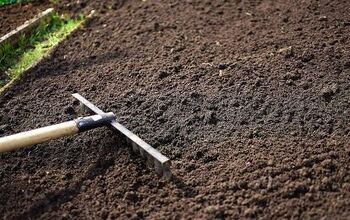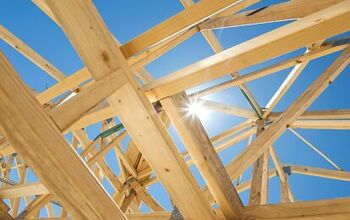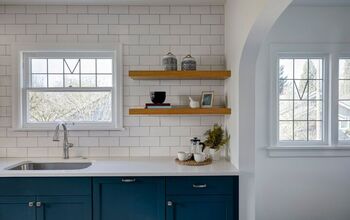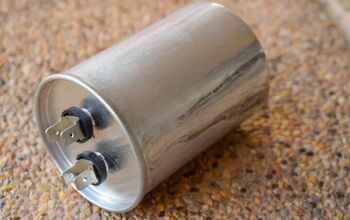How Much Weight Can a Stud Hold?

When trying to hang up decorations, TVs, shelving, or even lights on a wall, you have to take into consideration the wall studs throughout your home. So, the main question you have to ask yourself is: how much weight can a stud hold? We’re here to answer that for you right now.
A screw in a stud can hold an average of 80 to 100 pounds. An entire stud wall can hold an average of 25,000 pounds with even weight distribution. Construction screws can hold the most weight, while cheap drywall screws holds the least. That said, there are a few tricks you can use to increase the weight those screws can hold.
Before you begin your next construction or interior decorating project, take a quick look at this guide to help you maximize the functionality of your wall studs. We’ll go over how to maximize the weight your studs can hold as well as
How Much Weight Can a Screw Hold in a Stud?
Studs are boards that are used in the framing elements of your home and support the walls. They can carry vertical structural loads and hold windows, doors, insulation, and more in place.
A screw in a stud can usually hold 80-100 lbs, but there are tricks to increase the amount of weight it can hold.
They are spaced approximately 16 or 24 inches apart from center to center. They run along the wall and between the floor and ceiling. Drywall or plaster is attached to the edge of the studs to form walls.
How to Maximize the Weight Your Screw Can Hold in a Stud
The fastest way to increase the weight a screw in a stud can hold is by using several screws if possible. This way two screws can hold 160-200 lbs and increases the same with even more screws.
Putting a screw in the center of the stud will also provide the best stability and support. If you are placing shelves, this distribution will also help to keep the shelves from sagging.
If the item you are hanging spans several studs, make sure to use each of them. This will distribute your load and also allow you to double up on screws.
Video: Drilling Tips and Tricks (and Mistakes to Avoid)
Construction Screws vs. Cheap Drywall Screws
The grade of the screw you are using matters as well. A cheap drywall screw will hold less weight than a construction screw. Construction screws also have thread cutting, which makes it much easier to place things. It is always a good idea to use better screws if you are hanging something heavy, even if they are more expensive. You’ll find it will save you time and money in the long run.
Doing the Math: An Example
If you consider an 8-foot span of shelves, the studs will be 16 inches apart. There should then be five studs over this area. Using two screws per stud, each of the shelves can support 800-1,000 lbs. The shelves weigh about 30 lbs. They will be used to support roughly 40 lbs of storage items.
An entire wall of studs can typically hold 20,000-30,000 lbs using this method.
The takeaway from this example is that you want your screw and stud to be more than strong enough to hold the item. To do this, double up on screws. Overbuilding is very important, so it all does not come crashing down.
Benefits of Using Studs
When hanging heavy objects such as pictures, mirrors, shelves, or TV mount systems, they must be anchored to the stud using fasteners or hangars.
Often times, hanging such heavy objects cannot be done on the wall alone as it is not strong enough. Studs also hold fasteners longer so they will not pull out due to the weight of the object you are hanging.
The best placement of a fastener is in the center of the stud as it provides the best support.
Steel studs are found in some homes that may require specialty fasteners. These could include toggle bolts to support heavy, bulky items. You can check for studs by running a magnet along the length of a wall. Wood studs will have nails and screws attract the magnet.
Steel studs, on the other hand, will have a strong attraction along the entire height and length of the stud. Another option is to use an electronic stud finder, which can usually detect metal in the wall.
How to Find a Stud
There are two methods you can use to help you find a stud for your walls. The first way is by using an electronic stud finder. If you’re not having any luck there, you can also manually find the right fit. While the latter option takes more time, it is a surefire way to get the perfect stud for your walls.
When using either method to find a stud, make sure that you are in fact locating studs. Other objects such as pipes or conduits may appear to be studs but are not. When you think you have found a stud, check several points on it to make sure that it is vertical.
Find several studs and measure the distance between them to make sure they are 16 or 24 inches apart from center to center. If the measured distance is different than this, you have probably located something other than a stud.
TIP: Run a strip of painter’s tape along the length of the wall and mark the locations to know where the studs are.
Using a Stud Finder
If there is drywall in your home, using a stud finder is fast and accurate way to locate studs. A stud finder is less efficient on plaster walls but may have a helpful metal-scanning feature. This feature can help you locate the nails securing the plaster to the stud.
To find a stud using an electronic stud finder:
- Find how high on the wall you would like to begin looking for a potential stud. This should be based on the installation height of the fastener you are using to secure the desired object.
- If necessary, calibrate the stud finder. This is usually done by positioning it on the wall where no stud is located and activate the finder. If it is calibrated, the stud finder will indicate it. If not, move and try again. Make sure to follow the manufacturer’s instructions to have the best results.
- Move the stud finder along the surface at the height of the desired fastener. The stud finder will signal when it senses the stud. Mark the location of the stud. If necessary, recalibrate.
- Find the other edge of the stud and mark it. This mark should be approximately 1 ½ inches from the first. Mark the midpoint as this is the center of the stud.
- Find several points on the stud and find other nearby studs using the steps above. This will make sure you have successfully found a stud.
Finding a Stud Manually
If you’d rather find your studs for yourself, you can use this manual method instead:
- Estimate the stud locations by looking at the wall. On drywall, these will look like raised or sunken imperfections that are vertical. These indicate fasteners that secure the panels to the studs. This will give you an estimation of the center of the studs.
- Tapping the wall with your hand or a hammer may help you find a stud. A low, hollow sound indicates no stud is present. Tapping over a stud produces a higher, solid sound.
- When you believe you have found a stud, indicate the location. If needed, measure the distance between studs as they should be 16 or 24 inches apart. To confirm the presence of a stud, drive a small finish nail. If it is a stud, you should feel resistance. You may need to repair the hole after removing the nail, however.
So, How Much Weight Can a Stud Hold?
Typically, a stud will hold between 80 and 100 pounds, but you can increase the amount of weight by doubling or even tripling the amount of screws you use. You can also increase the weight by properly distributing the screws and using a better grade of screw.
Finally, make sure that you are aware of other things that may be in the wall when you are locating studs. This includes ducts, electrical wire, and water pipes. You must be careful when installing fasteners around these items.
Related Guides

We are a team of passionate homeowners, home improvement pros, and DIY enthusiasts who enjoy sharing home improvement, housekeeping, decorating, and more with other homeowners! Whether you're looking for a step-by-step guide on fixing an appliance or the cost of installing a fence, we've here to help.
More by Upgraded Home Team



















![How To Reset A Whirlpool Cabrio Washer [In 5 Easy Steps!]](https://cdn-fastly.upgradedhome.com/media/2023/07/31/9076531/how-to-reset-a-whirlpool-cabrio-washer-in-5-easy-steps.jpg?size=350x220)







